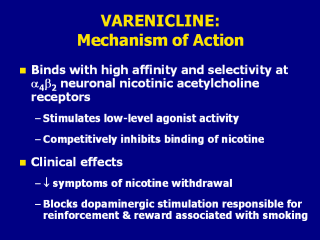| front |1 |2 |3 |4 |5 |6 |7 |8 |9 |10 |11 |12 |13 |14 |15 |16 |17 |18 |19 |20 |21 |22 |23 |24 |25 |26 |27 |28 |29 |30 |31 |32 |33 |34 |35 |36 |37 |38 |39 |40 |41 |review |
 |
Varenicline binds with high affinity and
selectivity at α4β2
neuronal nicotinic acetylcholine receptors. The efficacy of varenicline in
smoking cessation is believed to be the result of low-level agonist activity
at the receptor site combined with competitive inhibition of nicotine
binding. The partial agonist activity induces modest receptor stimulation
that attenuates the symptoms of nicotine withdrawal. In addition, by
blocking the ability of nicotine to activate α4β2
nicotinic acetylcholine receptors, varenicline inhibits the surges of
dopamine release that are believed to be responsible for the reinforcement
and reward associated with smoking (Foulds, 2006; Pfizer, 2006). Foulds J. (2006). The neurobiological basis for partial agonist treatment of nicotine dependence: varenicline. Int J Clin Pract 60:571–576. Pfizer, Inc. (2006, May). Chantix Package Insert. New York, NY. Slide is used with permission, Rx for Change: Clinician-Assisted Tobacco Cessation. Copyright © 1999-2007 The Regents of the University of California, University of Southern California, and Western University of Health Sciences. All rights reserved. |